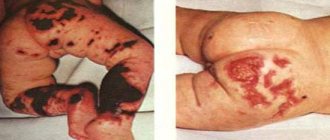- Dementia in adults
The medical term for dementia is dementia resulting from organic damage and improper functioning of the brain. It occurs as an independent disease, or as a secondary side symptom of another illness. Making a diagnosis requires several procedures and examination of the active brain.
Symptoms and signs of dementia
It is important to note that the manifestation of certain symptoms presupposes a preliminary determination of the cause of dementia, as well as where the brain damage is localized. It is customary to distinguish several stages of dementia, depending on the developing symptoms.
Symptoms of senile dementia
Symptoms of mental retardation can vary. The determining factor is the initial diagnosed disease, which serves as an impetus for the onset of dementia. Often at the initial stage the following symptoms can be identified:
- Decreased physical activity
- Lack of previous interests
- Development and appearance of apathy
- Formation of persistent dependence on close relatives.
As intellectual activity begins to decline, a person loses the ability to care for himself independently. Living alone in your own space becomes impossible and life-threatening. A person begins to forget whether he used electrical appliances or whether the gas was turned on. Therefore, constant monitoring by other people or representatives of social protection will be required.
Signs of senile dementia
The development of intellectual or thinking dementia is slow and gradual. Often, the disease is diagnosed at a later stage, since the first stage can be latent. The hallmark signs of dementia include impairments in the following areas:
- Decreased memory functioning
- Mental abilities deteriorate
- Manifestation of negative emotional background
- Physical capabilities become limited
- Behavioral changes and impaired communication skills
- The perception of the world and surrounding events is distorted.
The increase in the manifestation of the corresponding symptoms occurs slowly, and the rate of degradation also depends on negative external factors.
Features of oligophrenia
This phenomenon belongs to a wide group of diseases that are associated with developmental disorders. It is considered to be an abnormal underdevelopment of a person’s mental state, his personality and even the whole organism. Every hundredth person in industrialized countries suffers from this disease. Moreover, more than 3/4 of this number have mild mental retardation. There are twice as many men with oligophrenia as women.
It is not possible to conduct more accurate statistical studies because there are differences in the diagnosis of this disease, in the degree of society's tolerance for mental disorders, and in the availability of medical care.
Oligophrenia is not a progressive disease. This is most likely a consequence of a previous serious illness. The degree of mental retardation of patients with this disease is assessed by a special coefficient, which is derived on the basis of psychological tests. It is extremely rare for oligophrenics to be recognized as incapable of adapting to life in society.
Symptoms of dementia in adults
The first symptom that may indicate the onset of dementia is impaired intellectual activity and pathological memory loss. At the onset of the disease, the functioning of short-term memory deteriorates. For example, the patient cannot remember where he put the thing or object.
The second aspect is deterioration in thinking. Over time, building a logical chain becomes an impossible task. It is impossible to plan a plan even for a short period of time, to determine for yourself a solution to problems that require a quick solution.
Concentration also suffers, since the patient cannot control several objects at the same time. It becomes difficult to quickly respond and switch from one object to another.
Higher functions operate in a pathological mode:
- Aphasia. The patient cannot find the right words or phrases to express his own opinion
- Apraxia. Inability to purposefully perform certain actions. Skills that have been performed for years can no longer be fully reproduced
- Agnosia. Inability to really perceive current events.
Also, during the development of dementia, orientation in space is disrupted. Depending on the development of the pathology, often the patient cannot remember where his home is.
Qualified help for oligophrenia
The Salvation Clinic provides treatment for debility and imbecility in inpatient and outpatient settings. Specially trained, highly qualified personnel (speech therapists, psychologists, psychiatrists, psychotherapists) work with patients. The clinic fully complies with international standards. There is a modern renovation, good diagnostic capabilities, and conditions for healing the psyche and body. We offer:
- European health care service;
- high quality of psychotherapeutic assistance;
- progressive correctional methods for the development of social skills, speech, thinking, attention;
- moral support of relatives;
- 24-hour counseling;
- a real chance to socialize, return to normal life without restrictions;
- courteous attitude towards patients;
- affordable prices for the treatment of mental retardation.
In case of idiocy, hospitalization in a specialized hospital is provided. We provide accommodation in separate rooms with all amenities. The rooms are equipped with orthopedic furniture, television, private bathroom, and air conditioning. You can install an individual nursing station. Patients are under constant supervision of responsible staff. Adequate fortified nutrition, rest, and a variety of leisure activities are provided. Outdoor walking tours are offered daily. The clinic is located in a park area, we have a landscaped area. There is specialized security. Isolation from the external environment is ensured, which is especially important in severe mental retardation, in which the following complications may occur:
- attempts to commit murder/suicide;
- socially dangerous behavior;
- excessive aggressiveness.
In a calm environment with proper care, the patient can relax and live a happy life. We provide a report on the patient’s condition at the first request of relatives, and we carry out our work conscientiously. Contacting our center is a real opportunity to improve the quality of life of a loved one with mental disabilities and allow themselves a break. It is difficult to come to terms with the idea that a loved one is not like everyone else. We will be able to share the burden of responsibility with you and provide proper care to the patient. Contact us, there is no need to be alone with your problem!
Dementia treatment
It is important to take into account that the full extent of senile dementia is incurable. However, with the correct selection of drug treatment and psychotherapy, it is possible to slow down the process of brain damage. Some patients, due to self-criticism, begin to hide their disease from prying eyes and doctors, which only complicates the treatment process.
The use of medications is necessary if the patient is diagnosed with sleep problems, the development of a depressive state, or the occurrence of hallucinations. Stimulants, vitamin complexes and neurometabolic stimulants help improve blood circulation in the brain.
Tranquilizers help cope with increased anxiety, and antidepressants help with the development of depression over a long period of time.
In combination with drug therapy, the patient must interact with a psychotherapist who develops an individual interaction program using proven techniques. If dementia is in its early stages, it is recommended to interact with other people as often as possible.
Classification of oligophrenia
There are several types of classification of this pathology. The first divides it into:
- primary, which includes genetic mutations;
- secondary, which arises due to other factors.
There is also a classification created by M.S. Pevzener and modified in 1979. She divides oligophrenia into:
- light;
- having disturbances in the processes of inhibition and excitation;
- having disturbances in the functioning of the analyzing system;
- with a predominance of psychopathic forms of behavior;
- with severe underdevelopment of the frontal lobes of the brain.
Diagnosis of dementia
Diagnostic measures are aimed at identifying specific aspects and signs characteristic of the manifestation of dementia. During the conversation, the specialist identifies memory problems. If there is a suspicion of the development of dementia, measures are taken to establish apraxia, agnosia and aphasia.
Dementia in adults
In the process of developing dementia, nerve cells in the brain begin to die, which often occurs due to disturbances in metabolic processes, the development of oncology, or problems with blood vessels. Among the main diagnostic methods, the following can be distinguished:
- Psychiatric examination, medical history, complaints
- Visiting a neurologist and conducting a thorough examination
- Passing psychological tests that identify pathological functioning of memory, thinking, and concentration
- Testing for the biochemical composition of blood
- MRI, CT, EEG, neurotest.
The development of dementia affects all types of brain activity: the emotional sphere, abstract thinking, memory and attention. Often an adult becomes capricious and infantile, like a child.
Dementia in children
The clinical picture is determined based on age-related diagnosis. A school-age child may experience cerebral lesions. There is a contrast between the level of development of skills, erudition, and cognitive activity. The child can develop a sufficient vocabulary; it fully describes each experiencing event.
The possibility of abstract thinking is completely or partially absent. A child is unable to understand a joke or explain the meaning of a proverb; it is impossible to transfer life experience to a specific situation.
Regarding younger children, their symptoms are different. The main criterion is psychomotor arousal. There is no emotional stability: the child does not feel longing for his parents, a connection with his mother is not formed, and there is no instinct of self-preservation.
Mental dementia
Mental dementia is a pathological form characterized by deterioration of intellectual activity. As a result, a person does not have the opportunity to build connections between the real world around him and his own imagination. In addition to impaired cognitive function, emotional poverty is observed. Over time, a person’s vocabulary begins to gradually become poorer.
It may be an acquired or congenital pathology. The cause of the development of mental dementia can be any organic damage to the brain. Elderly people are at risk, but every year the number of young people suffering from this disease continues to increase.
Dementia in the elderly
As we age, brain activity begins to slow down, resulting in dementia in old age. A person is unable to remember a large amount of information and is unable to navigate the area. As it progresses, he loses the ability to care for himself independently. Since the memory function is greatly weakened, there is danger and threat to the patient's life.
The degradation of mental potential occurs gradually and can be associated with many reasons: mechanical damage, hereditary aspects and the result of aging.
May appear as a side effect of diseases such as Alzheimer's, Pick's or Parkinson's.
Dementia - dementia
Dementia and dementia have many similarities. First of all, these can be congenital or acquired pathologies caused by third-party diseases, hereditary factors, or organic brain damage. A distinctive feature is a decrease in the ability for intellectual activity, thinking, concentration and the ability to fully explain one’s own thoughts.
As it progresses, the patient experiences emotional impoverishment. A person is unable to rejoice or show negative emotions. It is worth noting that the patient in adulthood begins to show signs of childish behavior (becomes capricious, demands attention to his person).
Chronic dementia
Throughout the entire period of research, experts have not been able to find a medicine that will fully cure dementia. Accordingly, as it accumulates, the disease becomes chronic. To prevent dementia from progressing further at a rapid rate, it is only possible to prescribe supportive procedures that will help slow down the decline in intellectual activity.
Alcoholic dementia
With constant consumption of alcoholic beverages in large dosages, ethyl alcohol accumulates in the body, which negatively affects the functioning of neurotransmitters. They are responsible for the work of the emotional component. As alcoholism develops, a person experiences impaired functioning of memory, emotional manifestations, and inability to concentrate. A distinctive characteristic from other manifestations is a persistent disruption of the functioning of neurons under the influence of ethyl alcohol.
Temporary dementia
Temporary dementia often occurs as a result of metabolic disorders, Alzheimer's disease, or a negative reaction to drug treatment. It is important to note that if a person is diagnosed with HIV or AIDS, temporary dementia may occur as a side symptom over time. The signs are the same as with the development of classic dementia.
Dementia in women
Dementia occurs in women for many reasons. In addition to the main diseases (Alzheimer's, Pick's disease), it is worth paying attention to the period of hormonal changes during menopause. The primary manifestations of dementia are a depressive state and decreased emotional response.
As it develops, a person’s intellectual activity slows down, thinking is impaired, there is a lack of attention and the ability to navigate the terrain.
Mental dementia
The main cause of mental dementia is impaired brain function. This may be mechanical damage, metabolic disorders. First of all, short-term memory suffers, the inability to concentrate one’s attention on more than one object. As it progresses, a person is unable to fully express himself because he forgets once well-known words.
Causes of mental retardation
All causes of this syndrome are usually divided into two types: congenital and acquired. The first include:
- prematurity of the child;
- genetic abnormalities;
- chemical or infectious damage to the fetus;
- exposure to ionizing radiation while inside the womb;
- birth injury;
- asphyxia.
Acquired causes of the development of oligophrenia include:
- central nervous system infections;
- head injuries;
- hypoxia of the brain.
Often mental retardation is caused by pedagogical neglect, characteristic of dysfunctional families. In addition, there have been cases of oligophrenia, the causes of which have not been fully elucidated.
Approximately 50% of cases of this disease are the result of genetic changes. These are mainly chromosomal abnormalities, which include Down syndrome and other similar manifestations. Sometimes mental retardation is caused by a dysfunction of certain genes or their mutation, the degree of which exceeds a thousand. In addition, oligophrenia can accompany diseases such as:
- Toxoplasmosis. Caused by parasites that accompany domestic animals. When ingested by a pregnant woman, they also penetrate into the fetus, causing many malformations.
- Phenylketonuria. Caused by a disorder of phenylalanine metabolism. As a result, a large number of toxic products of its breakdown are formed. If you start treatment in a timely manner, you can avoid the formation of oligophrenia.
- Microcephaly. It represents the formation of a skull that is too small relative to the size of the brain. Accordingly, the brain also slows down its growth.
- Hydrocephalus. It consists of the accumulation of too much fluid in the brain area due to obstructed outflow or too rapid formation.
DEBILITY OR MILD FORM
With debility, the least damage to the central nervous system is observed; this form of retardation is relatively mild. Children are able to pronounce small phrases, they are very observant and stubborn, their distinctive feature is their inability to deceive.
Debility can be of several types:
- uncomplicated debility. This condition is characterized by a lag only in intellectual development. There are no serious deviations in the emotional and volitional sphere;
- with complications in the form of disruption of analyzers. Characterized by secondary deviations;
- complications in the form of neurodynamic disorders. The pathology is accompanied by increased fatigue and poor coordination and develops after damage to the cerebral cortex;
- Frontal insufficiency, as a complication of debility, leads to the fact that the child’s arms become flaccid. He is generally unable to navigate in space, and his behavior becomes unmotivated;
- psychopathic behavioral forms lead to underdevelopment of all personal qualities. This is the most severe form of pathology.
Children with retardation are capable of learning in a regular school, but auxiliary programs and special techniques are used. During correctional and educational classes, children are able to learn to count, write and read, and they also acquire the simplest knowledge about the world around them and acquire the simplest work skills.
FORMS OF THE DISEASE
Mental retardation in children is usually understood as oligophrenia. But another form of this condition also occurs - dementia. These two pathologies have several significant differences:
- Oligophrenia is a condition that develops during fetal development or during the first 3 years of a child’s life. That is, such a defect is most often congenital. The causes of damage to the central nervous system in this case may be hereditary factors, birth injuries, in particular asphyxia, infectious diseases suffered by the mother during pregnancy, as well as parental abuse of alcohol and drugs.
- Dementia occurs in a child after three years of age. Organic damage to the central nervous system can occur as a result of brain injury or become a complication of an infectious disease (meningitis, etc.), and can also develop against the background of schizophrenia, epilepsy and other mental pathologies. Acquired dementia manifests itself in a decrease in intelligence, but before the defect occurs, the child’s development usually corresponds to the age norm.
In addition, today mental retardation often means low intelligence against the backdrop of pedagogical and social neglect. In the modern classification of diseases, this condition is described as a disorder of intellectual development.
Mental retardation can vary not only in the time of onset. The division into types is made based on the severity of the damage to the central nervous system, as well as the specific location. Traditionally, there are three degrees of oligophrenia: debility, imbecility and idiocy. However, the modern classification excludes these names, since they have long gone beyond the scope of medical terminology and acquired a negative social connotation. Today, mental retardation can be mild, moderate, severe or profound.










